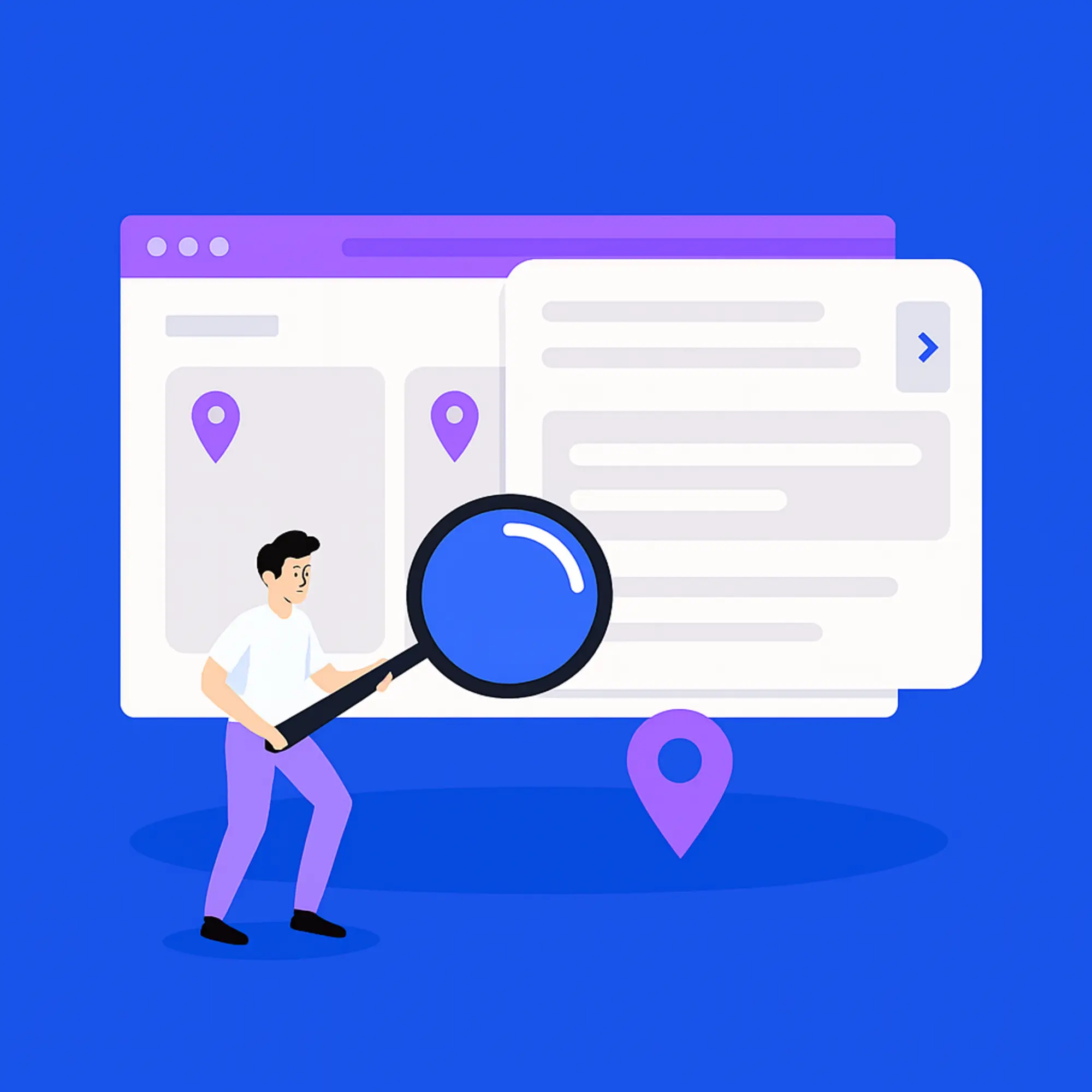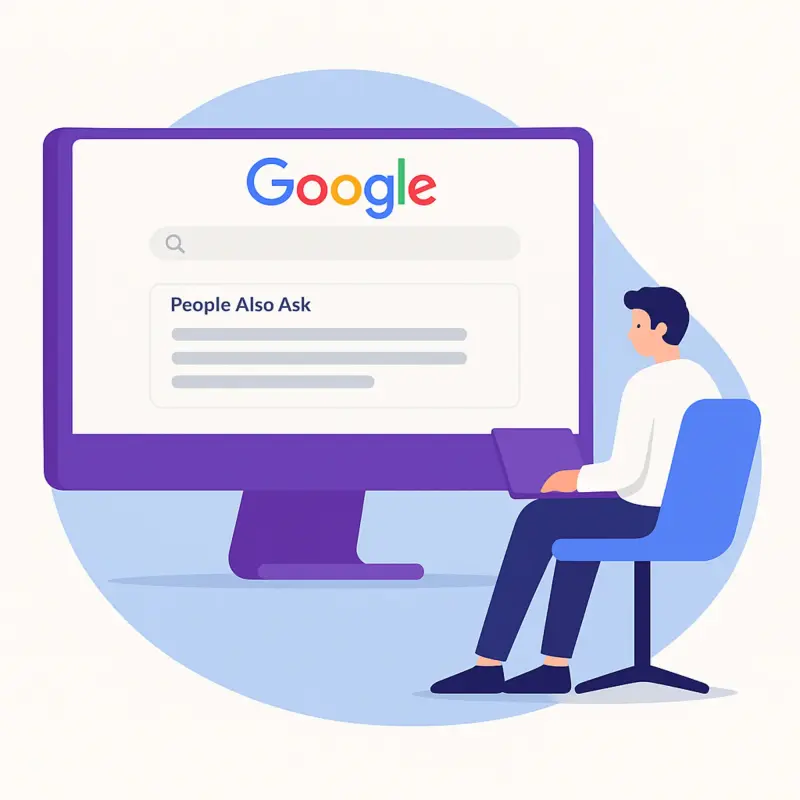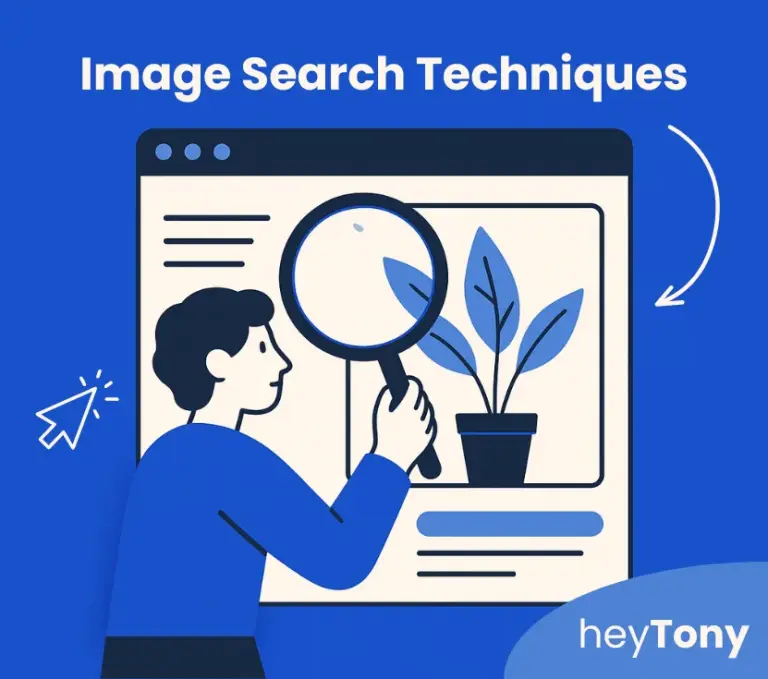TL;DR: What Are People Also Ask Boxes?
- People Also Ask (PAA) boxes are expandable question boxes on Google that reveal related queries and quick answers, offering another way to capture search visibility.
- They boost SEO by driving qualified traffic, uncovering new keyword opportunities, and putting your content above competitors on the SERP.
- To rank, focus on clear 2–3 sentence answers, lists, question-based headings, and optimized images.
- Use tools like AlsoAsked, AnswerThePublic, SEMrush, or Ahrefs to find and track PAA opportunities, then refresh old content to stay competitive.
- Avoid common mistakes like keyword stuffing, ignoring intent, or failing to update — businesses that get this right can turn PAAs into sustainable growth in traffic, leads, and conversions.
Search any question on Google and you’ll likely see a dropdown of related questions right below the top results. These expandable results are called People Also Ask boxes, and they’re one of the most powerful — yet often overlooked — ways businesses can claim visibility in Google search results.
Unlike traditional rankings that require climbing to position #1, PAA boxes give you another opportunity to show up in front of motivated searchers. They don’t just boost visibility; they help you capture highly relevant traffic and uncover new keyword opportunities. For businesses that want to stay competitive in today’s digital landscape, knowing what are People Also Ask boxes and how to rank in them is a game-changer.
As the leading agency specializing in SEO in Hamilton, HeyTony can help businesses turn missed opportunities into measurable growth. If you want more traffic, leads, and sales, let’s dive in.
What Are People Also Ask Boxes?
People Also Ask boxes (often abbreviated as PAA) are a Google SERP feature that displays related questions based on the original search query. When you click on one of the questions, a short answer snippet expands underneath, usually pulled from a third-party website. With each click, Google generates even more related questions, creating what feels like an endless loop of insights into how people search.
This isn’t just a quirky feature. It’s Google showing you the questions real people are asking — and handing you the roadmap for content that meets their intent. Businesses that align their content with these questions have a strong chance of appearing in these boxes, even if they’re not ranking at the very top organically.
How People Also Ask Works in Google Search
The mechanics of People Also Ask boxes are straightforward but powerful. Google uses machine learning and natural language processing to predict the most relevant related questions for a given query. Each time a user clicks to expand a question, Google “unlocks” more, effectively clustering together intent-based queries.
This means you’re not just seeing random guesses. You’re seeing live, evolving feedback People Also Ask results that tell you exactly what your potential customers want to know. For businesses, this is like free market research built into the search engine.
Featured Snippets vs. People Also Ask Results

It’s easy to confuse featured snippets and People Also Ask results because both provide quick answers. But here’s the difference:
- Featured snippets pull one primary answer to the original query and display it at the very top of the SERP.
- People Also Ask results expand into multiple related questions, each with its own featured-style snippet.
In practice, this means you can rank for featured snippets People Also Ask queries even if you don’t capture the main featured snippet. In other words, PAAs level the playing field, giving smaller businesses more chances to earn visibility.
Why People Also Ask Boxes Matter for SEO
For businesses trying to stay ahead, People Also Ask boxes are far more than filler content. They’re a strategic opportunity to expand reach, target long-tail queries, and meet customers where they already are in their search journey.
Increased Visibility on the SERP
When your website content appears inside a PAA box, it’s often displayed above or alongside the top organic listings. That means you don’t need to outrank huge competitors directly — you can leapfrog them by showing up in PAAs. The visibility is instant, and the credibility boost is significant.
Driving More Qualified Traffic and Leads
People who click through PAAs aren’t casual browsers. They’re motivated searchers trying to solve a specific problem. By appearing in a PAA, you capture users who are more likely to engage, subscribe, or purchase. Businesses in Hamilton and beyond can use this strategy to generate qualified leads, not just vanity clicks.
Discovering New Keyword and Content Opportunities
One of the biggest SEO challenges is finding the right keywords to target. PAAs solve that problem by handing you keyword opportunities on a silver platter. Every expanded question is a potential blog post, FAQ, or service page section.
How to Rank in People Also Ask Boxes
Ranking in PAA boxes requires strategy. It’s not about stuffing in the keyword; it’s about answering searcher intent in the format Google prefers.
Give a Direct, Concise Answer (2–3 Sentences)
Start every answer with a short, clear summary of 40–60 words. Keep it in active voice, remove jargon, and address the question head-on. This is exactly how you land inside People Also Ask boxes.
Use Lists and Bullets Instead of Tables
Google loves structured information. When appropriate, break down your answer into a numbered or bulleted list. Unlike tables, which sometimes don’t display properly, lists are scannable and mobile-friendly — two factors Google prioritizes when selecting how to rank in People Also Ask results.
Optimize Headings as Questions
This is non-negotiable. Frame your H2s and H3s as natural questions that mirror how users search. For example: “How do you optimize for People Also Ask?” signals to Google that your content directly addresses the query. This technique works for PAAs, FAQs, and even voice search for SEO.
Add and Optimize Images (Alt Text, File Names, Captions)
PAA boxes often display images alongside text. That means your visuals need to be properly optimized: descriptive file names, keyword-rich alt text, and captions where possible. Businesses often overlook this, but optimising images can significantly improve your chances of being featured in PAAs.

How to Optimize for People Also Ask with Free & Paid Tools
You don’t need a massive budget to start uncovering opportunities in People Also Ask results. There are both free and paid ways to mine this data.
Manual Google Searches and Free Extensions
One of the simplest ways to collect PAA data is to search your target keyword and start expanding the boxes yourself. This manual process takes time, but it’s free and incredibly insightful. Browser extensions can speed up the scraping process, though they can trigger CAPTCHAs if overused.
Using Tools Like AlsoAsked and AnswerThePublic
These tools turn messy data into actionable insights. AlsoAsked creates intent maps that visualize how queries are connected, while AnswerThePublic surfaces common phrasing of user questions. Together, they make it easier to plan content around real user behavior. This is exactly how to optimize for People Also Ask opportunities effectively.
Tracking People Also Ask with SEMrush and Ahrefs
Paid platforms like SEMrush and Ahrefs allow businesses to track whether they appear in PAA results and how that performance changes over time. This makes it easier to refine content strategies, identify gaps, and report ROI. For businesses investing in SEO, these tools are critical.
Using People Also Ask to Refresh and Repurpose Content
Google rewards freshness, and People Also Ask boxes are a perfect guide for refreshing your content.
Update Old Blog Posts with New PAA Questions
Look for blog posts that have lost rankings or traffic. Add in relevant PAA questions as new sections, framed as H2s or H3s. This keeps content aligned with current search intent.
Monitor Shifts in Trending Keywords
PAA questions evolve constantly. A trending query today might not exist in six months. By monitoring these shifts, businesses can adapt quickly and capture early-mover advantages.
Expand FAQs Into Full Articles
A simple FAQ section can serve as the seed for a full-length blog post. Each PAA question can become its own in-depth article. Agencies like HeyTony use this strategy to build entire content clusters that dominate SERPs.
For a step-by-step guide, check out our blog on Turning Your FAQs Into Blog Posts.
Advanced SEO Strategies with People Also Ask
Once you’ve mastered the basics, you can take PAA optimization to the next level.
Intent Clusters and Topic Mapping
PAAs often reveal clusters of questions tied to one user intent. Grouping these into topic hubs helps you cover multiple queries in one authoritative piece of content. Google loves this approach because it lowers the user’s “time to result.”
Trend Spotting for First-Mover Advantage
PAA updates in near real-time, often faster than traditional keyword tools. That means you can spot trending queries before competitors. Businesses that act fast can create timely content, attract backlinks, and establish thought leadership.
Using People Also Ask for Brand Research and Customer Feedback
PAAs aren’t just about ranking. They also reveal how people talk about your brand and competitors. For example, if PAAs surface questions about whether your service is trustworthy, that’s a signal you need to address customer concerns head-on. This is a goldmine for customer feedback loops.

Common Mistakes to Avoid When Targeting People Also Ask
Even with the best intentions, it’s easy to misstep when targeting PAAs.
Overstuffing Keywords Instead of Natural Placement
Yes, you want to use People Also Ask boxes and related terms often, but stuffing them unnaturally hurts readability and rankings. Google is smarter than that.
Ignoring Search Intent and Context
Answering the wrong intent is one of the fastest ways to fail. For example, if the query is informational but your answer is overly salesy, users will bounce. Always meet the user where they are in their journey— and if you’re unsure how, check out our blog on Understanding the 3 Types of Local Search Intent.
Forgetting to Check and Refresh PAA Data Regularly
PAA results change constantly. A piece that ranks today may be irrelevant tomorrow if you’re not updating content regularly. Make refreshing part of your SEO routine.
Final Thoughts: Why Every Business Should Care About People Also Ask
For businesses trying to grow online, People Also Ask boxes are an untapped opportunity that can pay huge dividends. They combine visibility, authority, and customer insights in one package.
Building Sustainable Growth Through Visibility and Authority
Ranking in PAAs consistently builds brand authority. It positions your business as the one that has the answers — literally — and that visibility compounds over time.
Turning Insights into Real Traffic, Leads, and Conversions
The power of PAA isn’t just clicks. It’s about capturing motivated users, guiding them toward solutions, and turning them into loyal customers.
Learn More SEO Tips and Strategies with HeyTony
Ready to capture more visibility and traffic through People Also Ask boxes?
At HeyTony, we specialize in helping businesses uncover missed opportunities and build sustainable growth through smart, targeted SEO. Check out our blog for more expert strategies or reach out today to start your journey.
Originally published . Last updated .
Categories:
Explore More



